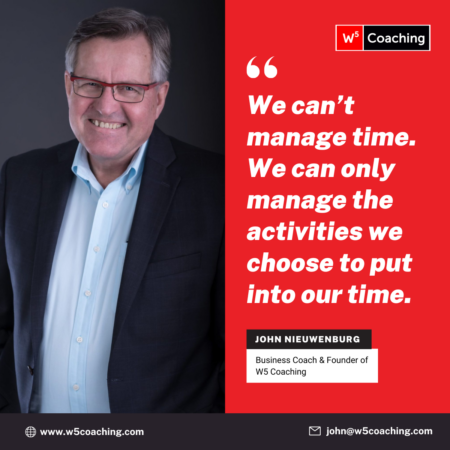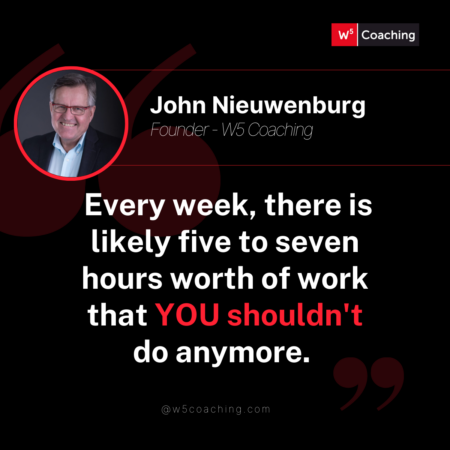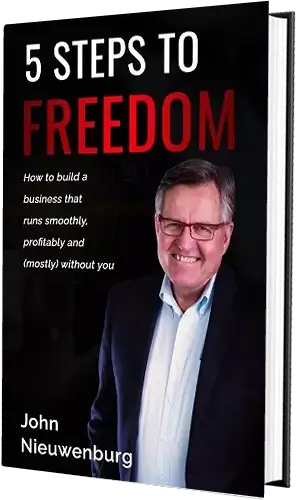Is Your Business Serving Your Life—or the Other Way Around?

I recently joined George Grombacher on his LifeBlood podcast to talk about a challenge nearly every small-business owner runs into: you’re highly skilled at what you do, but no one taught you how to run a business.
George and I covered why owners get overwhelmed, what keeps them stuck in the weeds, and the key question that helps you shift from being the technician to being the leader your business needs.
You can listen to the full episode here or read the summary below.
Most business owners I meet didn’t set out to become “the person who works 70 hours a week and never makes it to their kids’ games.”
Yet that’s where they land.
They start because they’re very good at something:
- They’re a great lawyer, accountant, therapist, chiropractor, or consultant.
- Or they’re a top-notch electrician, plumber, or HVAC technician.
They spend years getting certified and becoming true professionals.
Then they hang out a shingle… and discover something uncomfortable:
Just because you’re good at your trade or profession does not mean you’re good at business.
That gap—between technical excellence and business capability—is where most of my coaching work lives.
In this article, I want to walk you through how I think about that gap, why so many owners get “wrapped around the axle” of their business, and what has to change so your business can finally serve your life.
The Owners I Work With (And What They All Have in Common)
On the surface, my clients look very different:
- Owners of small advisory firms: lawyers, accountants, health practitioners, other professionals.
- Owners of trades and service businesses: electricians, plumbers, HVAC, and similar.
The work they do is different. But the business problems are almost identical.
Most of them come to me complaining—explicitly or implicitly—about one or more of these:
- Time
- “I’ve got too much to do and not enough time to do it.”
- “If I don’t do it, it won’t get done.”
- They’re working 60–70 hours a week and still feel behind.
- Team
- “It’s hard to find good people.”
- “I can’t get people to do the work to the standard I expect.”
- Culture issues, people issues, constant frustration.
- Money
- Weak or confusing financial reporting.
- No dashboard, no real KPIs.
- Or: “I just need more money—better sales and marketing.”
When the pain in one or more of those areas gets high enough, they reach out for help.
Wrapped Around the Axle: When the Business Owns You
A pattern I see again and again:
The owner becomes wrapped around the axle of their own business.
They’re in the weeds every day, fending off the next crisis, emergency, or “burning bush.” There’s always another fire to put out.
They know, at some level, this isn’t sustainable. But they’re capable, determined people. They tolerate it far longer than they should.
Then something happens:
- A health scare
- A relationship ultimatum
- A moment with the kids they miss (again)
And they say to themselves:
“I can’t do this anymore. Something has to change.”
That’s usually when I get the call.
The Most Important Question: What would have to be true in your business so that your business could serve your life?
When we first talk, I don’t start with “let’s fix your systems” or “let’s talk about your marketing.”
I start with a question:
What would have to be true in your business so that your business could serve your life?
Before we talk about the business, we talk about your life:
- How many hours a week do you want to work?
- What would you do with the time you get back?
- When was the last time you did those things?
A typical conversation might sound like this:
Me: How much are you working now?
Owner: About 70 hours a week.
Me: What would you like it to be?
Owner: If I could work 30 hours, that would be amazing.
Me: Great. What would you do with the extra 40 hours?
Owner: I’d go to my kids’ games.
Me: When was the last time you went to one?
Owner: …I haven’t.
When you say that out loud to another human being, it becomes very hard to ignore.
That’s often the first blinding flash of the obvious—a BFO. Once you see it, it’s obvious, but you couldn’t see it while you were in the fog.
From there, the real work begins.
“All Business Coaching Is Personal Coaching in Disguise”
A sentence that upsets some owners when they first hear it, but turns out to be true:
All business coaching is personal coaching in disguise.
Most owners think the problems are purely “out there”:
- We need better systems
- We need a new strategy
- We need a different tool or piece of software
Those things matter, but they’re rarely the starting point.
The real leverage usually sits in:
In other words: how you think and how you show up.
The question underneath almost every coaching engagement is:
Who do you need to become as an owner so that the business can become what you say you want?
The “Oh, Sh*t List”: Where 5–7 Hours a Week Are Hiding
Here’s something I see with virtually every client when we start:
They’re doing 5–7 hours a week of work they should not be doing at all.
To make that visible, I introduce a simple concept:
The “Oh, Sh*t List”
Your “Oh, Sh*t List” is all the stuff you say to yourself:
- “Oh, I have to do payroll.”
- “Oh, I have to do receivables.”
- “Oh, I have to send those invoices.”
- “Oh, I have to do estimating and proposals.”
These are usually:
- The tasks you dread
- The things you do at 10 p.m. or two days after they were due
- The work you procrastinate on because you dislike it or it drains you
Today, a huge chunk of that list can be handled by:
- A virtual assistant
- A bookkeeper
- A good admin
- Simple systems and automation
And here’s the uncomfortable truth:
You do have a virtual assistant right now. It’s you.
And you’re probably terrible at it.
You can hire someone overseas or nearshore for $15–$20 an hour who will do that work better than you and enjoy it more.
What do you get?
- 5 hours back to go to a kids’ game
- Or 5 hours to see more clients and generate revenue
- Or 5 hours to work on the business instead of in it
That’s the first practical lever we pull.
The 10–80–10 Rule of Delegation
A lot of owners resist delegation because they think it means letting go of quality.
It doesn’t.
I use a simple framework I call the 10–80–10 rule:
- First 10% – Your Job
- You give clear direction.
- You define the outcome, the constraints, and the context.
- Middle 80% – Their Job
- They do the heavy lifting—the messy middle.
- This is the part that causes you to say, “Oh, this is a pain.”
- That’s exactly what you want off your plate.
- Final 10% – Your Job Again
- You review, add your “special sauce,” and sign off.
- You bring your experience and judgment to the final decisions.
When you look at it this way, it becomes obvious:
- You still control quality.
- You still shape the final outcome.
- But you’re no longer the one grinding through 100% of the work.
That’s how you get your time back without standards collapsing.
From Technician to Owner to Investor
Another big shift we work on is identity.
Most owners I meet still see themselves primarily as technicians:
- “I’m an electrician who owns a business.”
- “I’m a therapist who happens to run a practice.”
- “I’m a lawyer with a firm.”
In the early days, that’s understandable. It’s you in a truck. Maybe your spouse doing some admin.
Then it’s:
- Two trucks
- Three trucks
- Five trucks
But your self-image doesn’t keep up.
You never make the leap to:
- Owner–operator
- Then leader–operator
- Then, ultimately, investor–owner
I like to use a Navy metaphor:
The 50-Foot Boat
You’re the captain of a 50-foot boat with a crew of 10. You’re also the most qualified engineer on board.
So what happens?
You’re in the engine room with tools in your hands, and trying to captain the ship.
Now upgrade:
- 150-foot boat
- Crew of 50
How often should that captain be in the engine room turning wrenches? Maybe in a true emergency, but there should now be a chief engineer.
Upgrade again:
- Aircraft carrier
- 2,000 people
The captain might go to the engine room to hand out a 20-year service award, but that’s about it. There’s someone who manages the person who manages the engine room.
Same person, completely different job.
Business ownership should go through a similar evolution. Your time shifts:
- From tools and tasks
- To people and systems
- To strategy and capital allocation
Or, more simply:
You go from being the doer, to being the leader of the people doing the doing.
Time, Team, Money: The Three Levers We Always Work On
Almost every project falls into one or more of these three buckets:
- Time – Get you out of the weeds
- Free up 5–7 hours a week by attacking your Oh list
- Use delegation and a VA or assistant
- Shift your calendar so you have time to work on the business
- Team – Stop being the bottleneck
- Hire and develop people who can take real responsibility
- Set standards and culture, not just tasks
- Learn to let go of control without letting go of accountability
- Money – Build a real financial dashboard
- Get proper financials and reporting
- Know your numbers instead of guessing
- Improve sales and marketing intentionally, not reactively
The specifics vary by business. The pattern doesn’t.
What Working Together Actually Looks Like
Owners often ask, “What does your coaching program actually look like?”
It’s simple on purpose.
- We meet for an hour a week.
- Each session should generate a couple of hours of work for you to implement.
- I ask you to have a “meeting with yourself” to do that work, not just show up and talk about it.
I work month-to-month, on a handshake basis:
- No 12-month or 24-month contracts.
- Coaching only works when it’s working.
- If it’s not, either of us can decide to stop.
In practice, engagements tend to fall into two patterns:
- Shorter-term (around 6 months)
- We solve a “burning bush” problem: payroll, cash flow, a major team issue.
- Once the immediate pain is gone, some owners feel complete at that stage.
- Longer-term (years)
- I become a grey-haired mentor, sounding board, and informal board member.
- Their business grows, and their role keeps evolving, so the work keeps evolving.
In both cases, the goal is the same:
Turn your business into a vehicle that can give you the life you want.
“Isn’t That Selfish?”
Some people recoil when I say, “The purpose of your business is to give you, the owner, the life you want.”
It can sound selfish.
You probably wouldn’t phrase it that way to your team or your customers. And there is a paradox there.
Here’s how I think about it.
On an airplane, you’re told:
“Put your own oxygen mask on first before assisting others.”
Why?
Because if you pass out, you can’t help anybody else.
It’s the same with your business:
- If you’re burned out, resentful, and exhausted, you are not at your best for your team or your customers.
- If your business is driving you crazy, that’s not noble—it’s unsustainable.
Taking care of yourself as the owner is not about greed. It’s about responsibility.
When you’re resourced, rested, and clear-headed, you can:
- Lead better
- Serve your clients at a higher level
- Create better jobs for your team
- Make a bigger impact in your community
Everybody wins.
If You’re Ready for a Better Question
If anything in this resonates, here’s where I’d invite you to start:
Don’t start with “How do I fix my business?”
Start with:
What would have to be true so that my business could serve my life?
Write down your answer, in plain language. Be specific.
- Hours you’d work
- Money you’d take home
- How often you’d be at your kids’ games or on vacation
- What you’d stop tolerating
From there, the work becomes helping you figure out:
- What needs to change in your time, team, and money
- Who you need to become as an owner
- What you can stop doing, delegate, or systematize
If you’d like help thinking that through, book a free 15-minute call with me.

Build a Self-Managing Company
How to build a business that runs smoothly, profitably, and (mostly) without you.
Feeling stressed out and overwhelmed with a business that is taking all your time - and not giving you enough in return?
Are you finding it challenging to hire the right team (and get them to do the right things)?
I wrote this little guide for you!
Enter your details below to receive your free copy!
